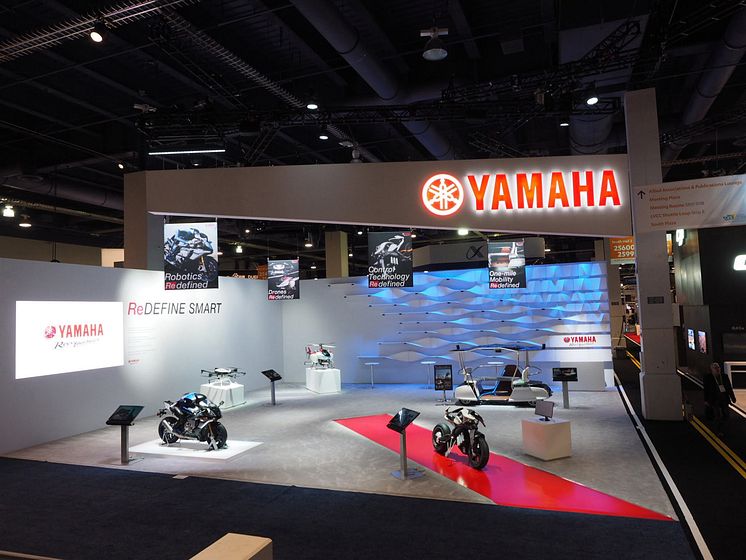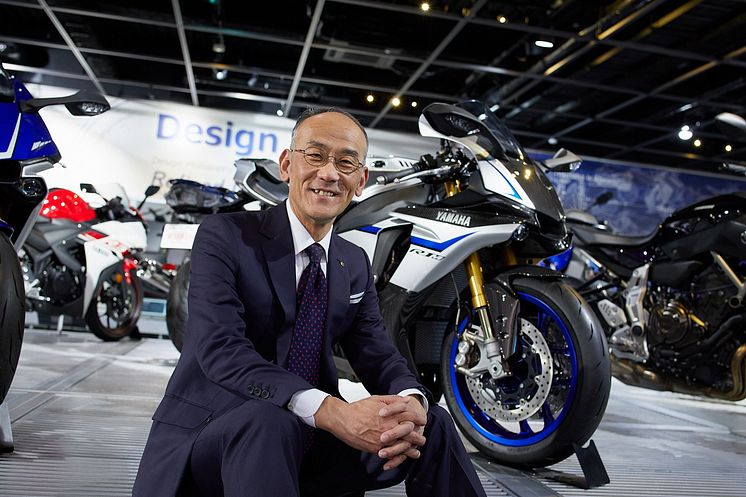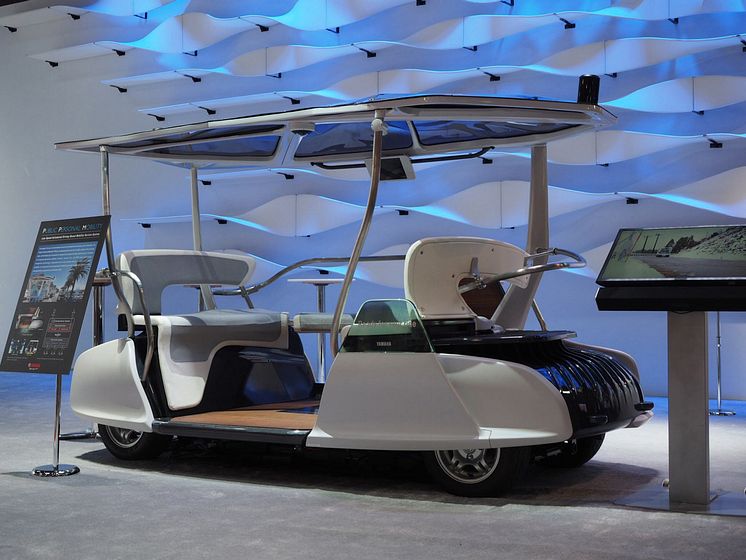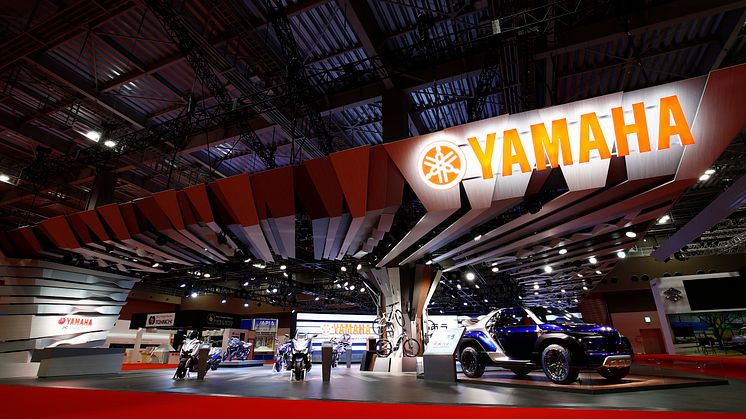
News -
Yamaha at CES 2018 –Showing New and Future Possibilities with Robotics Yamaha Motor Newsletter(Feb.15, 2018 No.62)
This year is the third and final year of Yamaha Motor’s current medium-term management plan. While striving to be a unique company that continues to achieve dynamic milestones in our many business lines, we are engaged in numerous initiatives aimed at achieving our annual goal of 2 trillion yen in net sales.
Amid these efforts, we exhibited at CES 2018, the world’s largest consumer technology trade show, for the first time this January. We had five models on display—including the MOTOROiD prototype that drew global attention at the 2017 Tokyo Motor Show—to exhibit the results of our latest R&D for advanced technologies aimed at expanding the possibilities of mobility—namely electronic control, automated driving and artificial intelligence.
In this issue, we introduce the aims and meaning behind the models and technologies from the show with quotes from a media interview with Yamaha Motor’s new president, Yoshihiro Hidaka.
Outlook: Robotics Is Key for Mid- to Long-term Growth
After Yamaha Motor was founded in 1955 as a new Japanese motorcycle manufacturer, the company began applying its powertrain technology to steadily pioneer new businesses, like outboard motors, snowmobiles, ATVs and portable generators.
The company also began work on its first FRP (fiber-reinforced plastic) boats around the same time as its outboards, thus expanding its marine products business and launching its swimming pool business with the resulting expertise in FRP construction.
We then developed devices to improve motorcycle production line efficiency, from which emerged our Intelligent Machinery business for industrial robots. Our corporate diversification continued and Yamaha became the multi-industry manufacturer we are today.
In the process, Yamaha Motor has continued to refine its core technical competencies in the fields of powertrains (from engines and water-jet propulsion to power-assist systems), chassis and hulls, and electronic control systems. We have applied them across our business lines and a broad range of new products in what is our uniquely Yamaha approach to Monozukuri (creating products with an emphasis on craftsmanship and excellence). Thanks to these efforts, we achieved net sales of 1.67 trillion yen in fiscal 2017 and the highest profits in our corporate history.
Yamaha Motor’s new President and CEO as of January 2018, Yoshihiro Hidaka, talked about this with the press in December 2017 (based on forecasts) prior to his appointment. “You can divide Yamaha’s businesses into three segments. One is Mobility, like our motorcycles, electrically power-assisted bicycles, ROVs and ATVs. Another is our Marine segment centered around our outboard motors and watercraft. The third is Robotics, comprised by B2B products like industrial robots, surface mounters and industrial-use unmanned helicopters.
“Our Mobility segment accounts for the largest share of our net sales, with the total figure for all our mobility product categories exceeding 1 trillion yen. The Marine segment is quickly approaching 300 billion yen, and I expect we’ll be within reach of 2 trillion yen in annual net sales with just these two segments within a few years.
 Yamaha Motor’s new President and CEO, Yoshihiro Hidaka, has long years of experience in Yamaha’s motorcycle business in Japan and abroad. A bike enthusiast himself, he currently rides a YZF-R1M.
Yamaha Motor’s new President and CEO, Yoshihiro Hidaka, has long years of experience in Yamaha’s motorcycle business in Japan and abroad. A bike enthusiast himself, he currently rides a YZF-R1M.
“As for the Robotics segment, results have been strong. Our new factory boosts production capacity for our industrial robots and surface mounters by a factor of 1.7, and with the shift toward creating smarter factories in the consumer electronics industry, the facility has been firing on all cylinders. Our existing lines of business in the Robotics segment puts net sales in the area of 100 billion yen, but considering the global need to address the shrinking labor force in the agriculture industry and the necessity to adapt to the progress that awaits with ‘smart societies,’ we expect the Robotics segment to see the biggest jump in terms of growth rate going forward. Like how we applied our surface mount technology to develop the CELL HANDLERTM and open a path into the biomedical industry, in 2018 we intend to increase both the level and speed of investment in this segment compared to our Mobility and Marine segments.”
The Unique Style of Yamaha: Fusing Mobility and Robotics
Yamaha Motor first ventured into the field of robotics in the mid-1970s, developing robots to aid in assembly and thus increase the efficiency of our motorcycle production lines. After that, Yamaha began selling robots to other companies, leading to the start of our Intelligent Machinery business and commercialization of Yamaha surface mounters, machines that place electrical components on printed circuit boards for electronic devices.
Facing both stiff competition and the rapid pace of industry advances, Yamaha endeavored to better its technical expertise in areas such as servomotor control for precise and high-speed operations, controller development based on strict quality standards and the signal-processing essential for ensuring stable operation in tough environments.
These technologies were eventually put to use in a wide variety of mobility products and took them into new realms of functionality and performance, like remote-controlled flight of our industrial-use unmanned helicopters, the control systems for motorcycle engines and suspensions, and electrically power-assisted bicycles that use electric motors to augment human pedaling power.
The great potential President Hidaka speaks of for the Robotics segment encompasses not only our Factory Automation (FA), Surface Mount Technology (SMT) and Unmanned System (UMS) departments, but also extends to the creation of entirely new products and/or businesses made possible through cross-integration with our existing product lines, such as MOTOROiD, a proof-of-concept prototype introduced at the 2017 Tokyo Motor Show aimed at developing new forms of personal mobility in which the rider resonates harmoniously with the machine.
In order to accelerate development of products and technologies as well as subsequent commercialization, Yamaha Motor implemented some strategic organizational changes earlier in January. Namely, these were the establishment of the new Mobility Technology Center to take charge of new fields of mobility, and the new Advanced Technology Center to combine new business planning and advanced technology development work. In addition, the IM Business Unit was reorganized into the new Robotics Business Unit comprised of the SMT, FA and UMS sections in a move to further strengthen the corporate structure.
January also saw Yamaha participate for the first time in CES 2018, the world’s largest consumer electronics trade show. Held in Las Vegas in the U.S., Yamaha took advantage of the event’s profile to not only display the results of our development successes until now, but also seek new business opportunities.
CES 2018: Unexpectedly Large Response Fuels Expectations
CES is a trade show boasting a long history of over 50 years and attracts about 180,000 visitors and some 4,000 exhibitors from a host of fields, ranging from home appliances and communications to drones, audio/visual products and robots.
Many booths drew attention in relation to today’s widespread trend toward smart systems across numerous levels of society, such as electric vehicles (EVs), automated driving and AI. The Yamaha booth was located in the show’s Robotics & Machine Intelligence area and was based on the theme of “Re-DEFINE SMART.”
The aim of our CES entry was “open innovation.” Until now, we have developed unmanned models for the land, sea and air, conducted field tests for automated driving systems for compact electric vehicles based on our electromagnetically-guided golf cars, and exhibited our technology at the Tokyo Motor Show. “A lot of thought has gone into our development efforts until now,” says President Hidaka. “But doing everything in-house hasn’t led to the growth we’d hoped for and development speed hasn’t gone up either. At CES, however, you have people with ideas and values different from our own from all over the world gathering in one place seeking new business opportunities. So exhibiting at CES could be a very stimulating experience and perhaps lead to actual tie-ups or finding new partners for launching businesses. So we thought this could boost the speed with which we transform our ideas and technologies into products.”
There were five models on display at the Yamaha booth. For motorcycles, there was MOTOBOT Ver. 2, an autonomous humanoid robot designed for riding a motorcycle on the racetrack and already capable of speeds over 200 km/h, and MOTOROiD, a motorcycle employing AI-based owner recognition, Yamaha’s exclusive AMCES (Active Mass CEnter Control System) self-balancing technology and more, enabling it to come off its kickstand, stand still and move at slow speeds completely unassisted. For the air, we had the FAZER R industrial-use unmanned helicopter, a high-end model of Yamaha helicopters already at work in agriculture for crop dusting and more, and the newly developed YMR-01 electric multi-rotor drone prototype. The fifth model—and one that President Hidaka has particular interest in—was the 06GEN-based Public Personal Mobility (PPM) solution that combines Yamaha golf car technology, road image-recognition and cloud-based control servers to create a unique, automated mobility service system.
 Unlike Yamaha’s proven automatic driving system for golf cars using electromagnetic guidance, our Public Personal Mobility (PPM) solution displayed at CES 2018 uses a new automatic driving system based on camera-based image recognition of the road ahead. Visitors praised it as a system that could likely be quickly implemented.
Unlike Yamaha’s proven automatic driving system for golf cars using electromagnetic guidance, our Public Personal Mobility (PPM) solution displayed at CES 2018 uses a new automatic driving system based on camera-based image recognition of the road ahead. Visitors praised it as a system that could likely be quickly implemented.
“Since we’d already released information about most of these models at the Tokyo Motor Show and other events, we weren’t sure how much interest they would draw among CES visitors, but when the show opened we were amazed at the size of the response,” says the Yamaha representative from Japan in charge of booth planning and operation.
“CES visitors are primarily businesspeople with technical backgrounds who’ve come to talk business, so we were surprised at how many of them hadn’t received prior information about our products or technology. So in effect, all of our display models were meeting fresh eyes and interest. We ended up getting an endless stream of specific and technically-oriented questions. ‘Does the helicopter have a gasoline engine? What’s its payload?’ ‘What are you aiming for with MOTOBOT and MOTOROiD? What kind of technology are they using?’
“This was also the first time we unveiled our Public Personal Mobility automated driving system, and it was very well received as an incredibly simple and low-cost short-distance transportation system that visitors felt was not only real-world ready technically, but would also be quick to implement. Although more concrete business talks are what come next, we were pleasantly surprised by the amount of interest people showed.”
Should Yamaha continue exhibiting at CES, it may become an event wielding significant influence on the future of the company’s technological development and ways of doing business.

|
Message from the Editor CES is a show full of new possibilities and we successfully made our first entry as an exhibitor. It looks like the booth turned out to be an excellent place for seeing and experiencing firsthand the fruits of decades of Yamaha R&D and the vision we have for the future. We may soon be seeing the autonomous vehicles so talked about around town! I can’t wait to ride in one! On a personal note, this will be the last issue for which I will serve as editor. The next issue will be coming to you from Naoto Horie of Yamaha Motor’s PR Group. My almost three years as editor have made me feel that Yamaha Motor is a company full of passion, ideas and challenging undertakings that are more interesting the more I learn about them. It is my heartfelt wish that you will continue to watch the company’s development and this publication with interest. Thank you for reading! Ryoko Ota |



